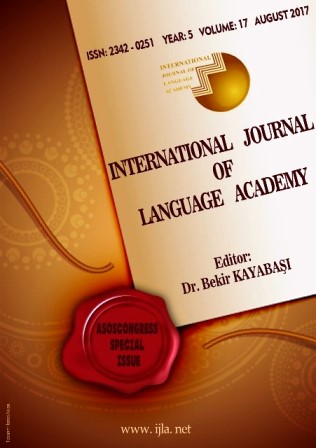Author :
Abstract
Divan edebiyatının gelenek haline gelmiş önemli unsurlarından biri de mahlastır. Mahlas; genel olarak şairlerin şiirlerinde kullandıkları takma addır. Mahlas konusunda yazılmış bu makale temel olarak iki bölümden müteşekkildir. İlk bölümde mahlasların gazel içerisinde kullanıldığı beyitler hakkında, ikinci bölümde ise; farklı bir mahlas kullanım örneği olarak mahlasın redif olarak işlenmesi hakkında bilgiler verilmektedir. İncelenecek tür olarak gazel nazım şeklinin tercih edilme nedeni; mahlasın gazellerde daha geleneksel biçimde kullanılmasından ötürüdür. Gazellerde mahlas, ekseriyetle bir defa olmak üzere çoğunlukla makta beytinde zikredilir. Ancak mahlasın birden fazla kullanımı, makta beyti dışında farklı beyitlerde kullanıldığı da görülmektedir. Bu kullanımların keyfî tasarruflardan ziyade bilinçli olarak tercih edildiği anlaşılmaktadır. Mahlası redif olarak kullanmak ise divan edebiyatı geleneği içerisinde daha orijinal bir yapı olarak dikkat çekmektedir. Genel olarak mahlasın bu şekilde farklı kullanımlarını şairlerin “geleneğin algısını kırmak”, “dikkat çekmek”, “yenilik getirme” hamleleri olarak yorumlayabiliriz. Bu çalışmada elde edilen bulgular 519 divanın gazeller bahsinin irdelenmesi sonucu elde edilmiştir. Bu çalışma ile divan edebiyatında önemli bir yere sahip mahlas geleneğinin daha iyi anlaşılması hedeflenmiştir.
Keywords
Abstract
This article is basically divided into two parts. In the first part, information is given about couplets in which the villages are used in gazel. In the second part; Information about the processing of penname as redif is given as a different mahlas use case. The reason for preferring the ophthalmic variant as the species to be studied; Because of the more traditional use of the penname in the gardens. The penname in the gardens are usually mentioned once in many times, usually once. However, it is also seen that more than one use of the mahlas is used in different couplets other than the maxilla. It is understood that these uses are largely consciously preferred from unconscious practices. The fact that the poets use the repertoire as a redif has attracted attention as a more original structure within the tradition of divan literature. In general, we can interpret these different uses of the mahlas as poets' attempts to break the perception of tradition, to attract attention, and to bring innovation. The findings obtained in this study were obtained as a result of examining the gazel section of 519 divans. This study aims to better understand the tradition of penname which has an important place in divan literature.
